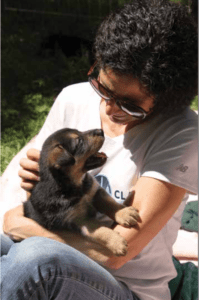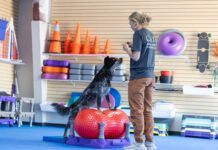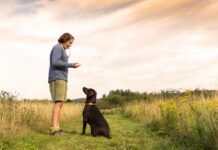When you see a little puppy, the most natural thing in the world is to run over and swoop her into your arms for a nice big cuddle!
I beg you: Don’t do that. It may feel wonderful to you, but the odds are you just created a moment of fear for that puppy.
PUPPIES GROWL OUT OF FEAR
Style matters, and the seemingly simple pick-up approach above includes three unfortunate choices: The surprise, the swoop, the squeeze. Each of those elements creates discomfort in a being who is new to our human world. (Nobody on Planet Dog picks anybody else up!) To complete the picture of terror, there’s often optional element #4: The Squeal.
Sometimes, people contact me in a bit of a panic because the puppy they got last week is growling at them, and it’s getting worse every day. A quick home visit usually reveals that these nice folks are in the surprise-swoop-squeeze camp. They are unintentionally terrifying their pup, and the pup is learning to fend off that moment with a growl.
While that’s a bummer, it’s also great news – because it means we can probably fix this in a jiffy by creating a new pick-up process that will build the missing trust.
RULE #1: NO SURPRISING!
It’s scary for puppies when they are picked up completely by surprise. One minute they’re just hanging out – maybe even sound asleep – and the next they’re up in the air! Sure, some pups will roll with it, but for many others it’s alarming.
You can avoid the surprise factor by altering your approach. No running! No zooming! Just stroll over so pup has a chance to see you’re on your way. Then crouch down, and take a moment to say hi with a gentle stroke. All along, provide a nice low-volume voice-over for extra reassurance and preparation: “Hi sweet pup. How about I come say hello?” That advance warning system means the puppy has a chance to catch up to the action.
Extra help: For a pup who has already been growling about handling, a cue word is a nice thing to add. A consistent heads-up in the form of a cheery, “1-2-3 time for a pick-up!” can be a game-changer. It helps pup learn to be ready when that’s about to happen and to totally relax when it’s not.
RULE #2: NO SWOOPING!
Even if you eliminate the element of surprise, you still may hear a growl if your pup feels unsafe in the air. That’s why the second rule of the perfect pick-up is this: No swoop-and-dangle allowed. Your new pup doesn’t want the thrill of an amusement park ride.
Help her feel safe with you by using a slow, cradling motion that keeps her body supported 100% of the time: One hand underneath, the other softly against her chest and shoulder. Bonus points for continuing your quiet voiceover: “Aw, there we go, we’re just going to move over here, you’re my sweetie girl . . .” Don’t stand up too quickly – give pup the old, creaky elevator experience rather than the one that whisks you ridiculously fast to the top floor.
Extra help: If you’re doing remedial work, it can help to have a chew, a toy, or a piece of jerky in your hand as you say, “1-2-3 time for a pick-up!” This way you can distract pup from her worries and create a positive association with the feeling of being handled in this way.
RULE #3: NO SQUEEZE-AND-TRAP!
Once pup is in your arms as you’re standing, you can extend her lesson in trust by slowly, gently putting her right back down. For some puppies, the worst part of a pick-up is the dreaded squeeze-n-trap! Humans love to trap puppies in what they call a loving hug. Alas, the puppy might call it terrifying jail time.
Nobody – not one human, not one dog – wants their body to be held against their will. And yet somehow we think puppies are supposed to sit endlessly in our laps, or cherish being carried around by us, so we make them do that regardless of their reaction. Kids are the ones who find this hardest to resist, but I’m amazed how many adults also refuse to recognize a puppy’s squirming as a legitimate plea for bodily autonomy.
To add to the train wreck, these over-held pups are often the ones who grow into dogs who hate being handled! Which is sad in all kinds of ways, because it’s the folks who most want cuddlers who tend to turn their dogs into resisters.
Here’s what I tell kids (and, ahem, a few adults): Do you want to be your puppy’s favorite? Then, especially at first, let that puppy do the choosing! Rather than demanding the puppy’s attention, entice it instead. Get down on the floor, get a squeaky toy, roll around in a puppy-like way – and soon enough that puppy will start choosing you to play with. And then, miracle of miracles, when she’s tired she’ll wander over and choose your lap to sleep in. Now you’re just one step away from that pup happily asking to be picked up and cuddled.

ALWAYS LOOK AT YOUR DOG’S BODY LANGUAGE
If you eliminate the surprise-swoop-squeeze from your routine, your pup will soon be calm about being picked up. To see if you’re at that point yet, look for the signals that pup is happy about this consent-based handling. Is she regularly approaching you? Turning her head toward you instead of away? Relaxing her body against yours? No longer struggling in your arms? Perfect. Now you can skip the warning cue, and the treat in your hand as you lift.
But the rest? The no-surprise approach? The soothing voiceover? The un-intimidating crouch? The slow, supported lift? Don’t drop those. It’s habits like those that eventually make people describe you as the one who is “just magic with dogs!”
Nope. It’s not magic, just empathy. Use it, and enjoy the rewards.







What a great article and thank you for writing it. I am a trainer and I see this all the time with puppies. Especially when children pick them up and the puppy is squirming around…I am always fearful the puppy will squirm right out of their arms onto the ground.
It is sad to me when I see adolescent dogs running from their humans when they try to pick them up, or, when it is time for a walk and the dog runs from the harness/leash. This behavior can be changed with patience and consistency over time. But, if we follow what this article says to do, then it can be “nipped in the bud” before it ever has a chance to happen!
Thanks again
Jody
This is GREAT advice! We are all guilty of it, more often than not. Also, getting the puppy to come to you first is great training for later on. Then it’s their choice. Excellent article.
This is also great advice for interacting with adult small breed dogs who sometimes get treated like puppies. It’s important to give children (adults too) who want to squeeze and trap. I trained my small dogs right away that when I say, “Pick-up” in a bright, calm voice that they are going to be transferred to a place they can’t jump to themselves, like inside the car or on to the bed.
One thing needs to be mentioned, puppies squirm out of excitement and joy too. They’re eager, exicited and want to join a litter mate already on the ground or whatever. There needs to be a firm grip for the sake of safety on that squirming puppy. I’ve had too many (not out of fear) but enthusiasm, try to “leap” from my arms. And that is a recipe for a pup falling and landing on its head. Another way of building trust towards that maneuver, is having a “goodie” in your hand, that makes them want to come to you. And after the pick-up, give them the other half. So they know being in your arms is the best thing ever.
As a working dog school, we usually hold our pups when they’re 8-weeks-old to about 11-weeks-old until they fall asleep. You can’t always put a puppy down if they want it due to what’s on the ground and we use it as a way of containment if we’re out in public and need them to settle / be quiet (hands on=settle down) and we need pups that will want to be held. We use adult trainers to do this (without kids around). Out of all of our pups, the ones that have been through holding sessions are the most affectionate. If this is not going to be done exceptionally well, then it does lead to pups that fear hands or do not want to be held.
Not a puppy, but a deaf and blind dog in my house, was never startled awake by being picked up from a nap. I always touched him and petted him to let him know I was there before picking him up.
My care for that dog is basically what is advised for puppies here. And for sure if the puppy is running and playing it is not the moment to run over and grab him and pick him up. A napping puppy should be treated the same way I treated the old blind and deaf dog.